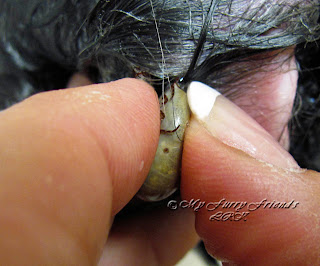Thanks to a lot of the topical flea and tick spot-on treatments, I don’t see very many ticks on dogs anymore.
If we find one it is usually in the tub, once the dog is wet.
If we miss one in the tub, the HV will defiantly find them.
Most of the ticks that we find are the common Brown Dog Tick, or the American Dog Tick.
Sometimes they are already dead or close to it, because of the spot-on treatment, and can be picked off very easily.
Other ticks may have recently attached themselves, and can also be removed fairly easily.
When bathing a Shih-Tzu the other day, my son found this female tick, engorged with blood.
This was the first time he had seen a female tick that was as big as this one.
She was so full of blood, she was just about ready to fall off.
I told him to lift her up and see if the male tick was still under her.
Sure enough, there he was.
If you come across a female tick, there will almost always be a male under her.Â
A female American, Brown, and Deer Tick will change size and color as she feeds and becomes engorged.
This is a female, American Dog Tick that is fully engorged on blood.
The brown and tan shield, just above her mouth, gives her away as a American Dog Tick.
The female Brown Dog Tick has a solid black shield, with a short mouth.
The female Deer Tick also has a solid black shield, but has a longer mouth.
The length of the mouth is one of the only ways you can tell a female Brown Dog Tick and Deer Tick apart when they are engorged.
Before removing a tick, I like to soak a cotton ball with alcohol and hold it on top of the tick for a few minutes.
Sometimes the alcohol makes the tick loosen its grip, and helps you to pull the tick off a little more easily.
Get your fingers as close to the ticks mouth and the dogs skin as possible.
Slowly pull up and twist a little at the same time.
I have found that I have much more control removing ticks with my fingers then with tweezers.Â
I don’t recommend tweezers, the pressure of the tweezers can sometimes cut through, and separate the body and head before you have completely removed the tick.
I have seen tick removers out there, but to be honest, I have never tried one.
The female has been feeding for a while, and has caused a sore to develop.
Repeat the removal process with the male tick.
(The female tick looked similar to the male before she started feeding.)
This ticks back is tan and black.
It is an American Dog Tick.
These ticks can carry Rocky Mountain Spotted Fever.
They do not carry Lyme disease.
 Both ticks have left a sore.
I clean the sores with Peroxide.
*Tips: ~Always tell an owner when you have pulled a tick of off their dog.
~Show them the spot if you can.
~If you think the tick could possibly be a Deer Tick, scotch tape it to an index card, and give it to the owner so that they can check with their Vet.
~Let them know that the sore will develop a scab, and most times a very large scab.
~Also let them know that the scab may be there for a few weeks before it falls off.
Before the spot-on treatments, I used to get dogs in that were covered with ticks.
When I used to clip before the bath, I would be clipping a dog and suddenly panic because I saw blood.
Let me tell you, it was no fun when your blade hit one of those engorged female ticks.
Talk about nasty and bloody.
I also had a Shepherd puppy come in once covered in ticks.
When I say covered, I mean covered.
You could not even count all of them.
We even found about 30 baby ticks in the webbing between each of his toes.
We found out later that the owner was keeping the puppy out in his wood shed.
Ugh!
One other thing, when my white St. Poodle was around a year old, she rolled over for me to scratch her belly and I found a perfectly round bulls eye mark on the inside of her thigh.
There was no tick, just the bulls eye.
I took her straight to my Vet and he confirmed my fears about a Deer Tick bite.
He said it was a text book Deer Tick bulls eye.
He also said that it was the first time that he has seen one so clear and perfectly formed on a dog.
He had all of his Techs come in and have a look.
Thankfully I found it in time.
So, whenever I find something similar on a dog, I tell the owner to have the dog tested for Lyme.
It is always better to be safe then sorry. 
Happy Grooming, MFF







没有评论:
发表评论